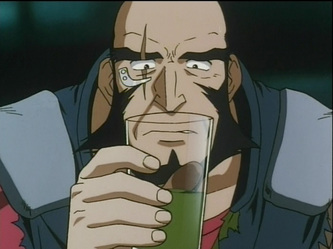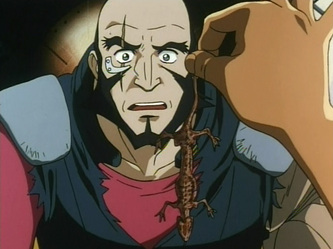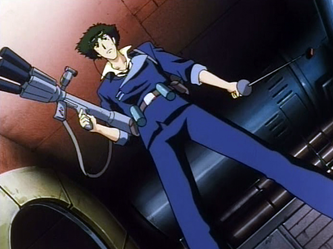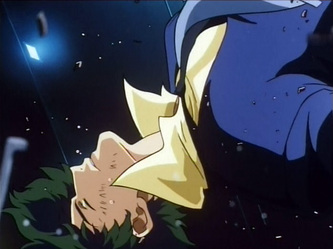Toys in The Attic: More Than a Parody
WARNING: This article contains ENDING SPOILERS
Toys in the Attic. Enigma of all enigmas. What happened after the entire Bebop crew got bitten by the mutant lobster? Did they really, as Ed cheekily pointed out in the Session 6 preview, die? It would be highly ironic if that were the case, the larger-than-life Bebop team losing the battle onboard their own ship to a glob of je ne sais pas. And why is it that, out of 26 beautifully choreographed sessions, this comedy of a story is the only one that gets the all important line, "The End"? To add to the confusion, one of the producers once claimed that everyone onboard supposedly dies in Toys in the Attic and everything after that is just a dream. Perhaps the CB creators are just toying with us. This is just one of those filler sessions; it is simply an entertaining parody of the movie Alien, a teaser done in jest to keep the poor fans puzzled.
And yet, Cowboy Bebop is a show laden with double entendres, parallels and metaphors. I belong to the camp that believes all CB sessions work towards one or another important underlying theme of the series and that none of the sessions are meant to be pure filler.
After all, the CB creators are a cheeky and subtle lot: the main plot device in Bohemian Rhapsody is an important piece in chess: the King. There appears to be another chess-related reference encrypted into the session: the song after which this session is named by none other than the famous band, Queen. Coincidence? I wonder. Consider Mushroom Samba, where the coffin-dragging bounty hunter sits at a cafe called "Moby Dic" (sic). The frog in Spike's hallucinations tells him that he is walking along the "Stairway to Heaven". The band Led Zeppelin happens to have a song by the same name, and "Moby Dick" is also one of their instrumental recordings. Two Led Zeppelin references in a session? Hardly a coincidence.
Furthermore, one can hardly imagine a more fitting setting for Vicious and Spike's confrontation than a majestic cathedral as shown in Ballad of Fallen Angels. The grand venue serves a dramatic purpose, but on a metaphorical level, a cathedral is also a befitting place for a battle between good and evil and a shot at redemption. (Thanks to effigy105 for pointing that out) Interestingly, this BoFA cathedral is not just any cathedral-- it is modelled after the famous Notre Dame of Paris.
After all, the CB creators are a cheeky and subtle lot: the main plot device in Bohemian Rhapsody is an important piece in chess: the King. There appears to be another chess-related reference encrypted into the session: the song after which this session is named by none other than the famous band, Queen. Coincidence? I wonder. Consider Mushroom Samba, where the coffin-dragging bounty hunter sits at a cafe called "Moby Dic" (sic). The frog in Spike's hallucinations tells him that he is walking along the "Stairway to Heaven". The band Led Zeppelin happens to have a song by the same name, and "Moby Dick" is also one of their instrumental recordings. Two Led Zeppelin references in a session? Hardly a coincidence.
Furthermore, one can hardly imagine a more fitting setting for Vicious and Spike's confrontation than a majestic cathedral as shown in Ballad of Fallen Angels. The grand venue serves a dramatic purpose, but on a metaphorical level, a cathedral is also a befitting place for a battle between good and evil and a shot at redemption. (Thanks to effigy105 for pointing that out) Interestingly, this BoFA cathedral is not just any cathedral-- it is modelled after the famous Notre Dame of Paris.
And let us not forget the parallels between Gren and Spike. From their last conversations with Faye to the way they are visually portrayed in the end to the fact that both men are essentially stuck in limbo in their own way, there is no denying that the CB production team made it a point to compare them on multiple levels. One can go on and on about the layered references planted throughout the show; depending on your areas of interest, one reference may make itself clearer to you than another. Suffice to say, the creators like to be subtle in their art, and the tricks they keep pulling out of the bag seem endless.
Could Toys in the Attic be another Ace up their sleeves? Notice how every single one of the four lessons each character teaches reveals a lot about the individual. As the most down-to-Earth crew member, Jet's lesson on honest work comes as no surprise. And true to form, Faye teaches: Survival of the fittest is the law of the land. To fool and to be fooled is the reason we live. I've never had anything good happen to me when I trust others. A lofty statement like "when you see a stranger, follow him!" could only be expected from the wacky, happy-go-lucky Ed. Likewise, Spike's lesson "Don't leave things in the fridge" is in line with everything that he does-- it's witty and practical. More importantly, it has a layered meaning.
The way I see it, Toys in the Attic is ultimately a metaphor for Spike and his past. Putting things in the fridge is akin to putting something away in preservation until the next time you take it out. But leave it in the fridge for too long and it begins to rot, no matter how wonderful it originally was. Spike traded the days with the syndicate for a life of a bohemian, a freelancing bounty hunter. He conveniently lets his past take a backseat in his present life until, in the Real Folk Blues, it comes back to haunt him with a vengeance and he has no choice but to face up to it. Only when he is forced to confront it does it evolve into a dazzling finale with Vicious, which costs him his life. Likewise, in Toys in the Attic, Spike is injured by the mysterious glob only when he tries to forcefully eject it from the ship. In both cases, it's implied that he dies, although we are never quite sure in either case because most of us take the "The End" tagline at the end of Toys in the Attic to be a joke and in the Real Folk Blues we never see much beyond Spike collapsing --so how do we know he actually dies? Personally, I'd say he died for sure in the last session, but that's another argument altogether. (See essay Reading Between the Lines)
All this, of course, is just my own interpretation of the session and I may be reading too much into it as a fan who believes that all sessions are interconnected and are working towards an absolute truth or message for the series. Cowboy Bebop is loaded with vague details and unanswered questions; much like the fragments in a kaleidoscope, they can be tilted this way or that to form very different pictures for different people. To end, I would like nothing more than to leave you with an elegant quote by Muse:
"...each session is a different kind of jewel strung together on a single unifying thread of a theme, with its end tied back to its beginning to form an almost perfect circle -- and a fine piece of visual entertainment art."
With this in mind, why not go rewatch Toys in the Attic someday? Perhaps another story will reveal itself this time round.
[by Leigh].
"...each session is a different kind of jewel strung together on a single unifying thread of a theme, with its end tied back to its beginning to form an almost perfect circle -- and a fine piece of visual entertainment art."
With this in mind, why not go rewatch Toys in the Attic someday? Perhaps another story will reveal itself this time round.
[by Leigh].
Want to share your thoughts on this essay? Join in the discussion in the Comments section:
HTML Comment Box is loading comments...
















